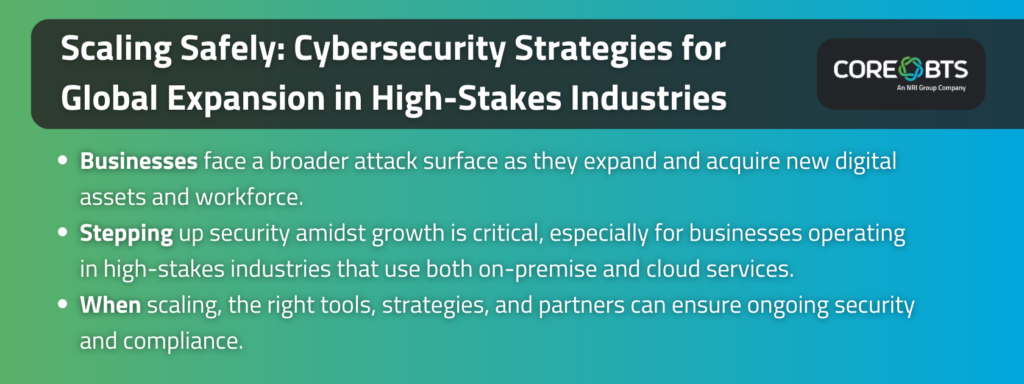A comprehensive security strategy is essential to safeguard your business’s on-premises and cloud data services as you grow and threats evolve.

Scaling your business can be a daunting experience, whether it’s investing in new markets, creating new business opportunities, acquiring new clients, or managing growth. Keeping track of everything can quickly become overwhelming.
Worse still, as your company grows, so does its attack surface-entry points vulnerable to cyberattacks and data breaches. Every new unsecured IT asset on-premise and in the cloud becomes a shiny toy with which nefarious actors can play.
Protecting all your organization’s assets and recovering from attacks can be extremely difficult without a robust security strategy. Plus, losing sight of your security posture is easy as other business expansion considerations(such as new services and products, sales, marketing, budgets, and ROI) take priority. Here, the value of a reliable partner truly shines by ensuring security considerations don’t get swept under the rug.
Read on to discover useful insights for sustaining security in both on-premise and cloud environments while scaling your business.
Expanded Attack Surface: The Unavoidable Element of Business Growth
As a business scales, investing in additional IT assets and human resources becomes necessary to manage increasing data and workloads. Most expanding businesses will add new employees, workforce endpoints, IoT devices, apps, digital services, systems, and processes.
Though essential to operations, these additions widen the business’s exposure to top cyber threats, such as:
- Social engineering
- Ransomware
- Distributed denial of service (DDoS)
- Advanced persistent threats (APT)
- Attacks on IoT devices, third-party services, and misconfigured and unpatched software
Therefore, stepping up security amidst growth is critical, especially for businesses operating in high-stakes industries that use both on-premise and cloud services.
Though the increasing number of hidden vectors and entry points threat actors can exploit might be discouraging, it’s nothing that can’t be fixed with proper risk management.
Improving Visibility with Microsoft Defender
One of the challenges businesses face when scaling is poor visibility of assets and attack surfaces. Here, deploying Microsoft Defender, a unified endpoint security platform that provides advanced threat protection across various devices and environments, can be game-changing. It runs periodic checks to provide a full view of the assets connected to your network and uncover risks and vulnerabilities.
More crucially, Microsoft Defender provides custom configuration capabilities to help better protect applications, data, identities, and devices from malicious cyber threats. It recommends the best actions to remedy identified weaknesses, making it easy to review, prioritize, continuously monitor, and improve security measures as you grow.
The Value of Penetration Testing
Another hands-on approach for scaling safely is penetration testing. Through penetration testing, you can double-check the security of digital assets before adding them to your on-premise and cloud environments. For example, you can scan and test the code of new assets to ensure it complies with standards and identify errors, misconfigurations, weaknesses, and bugs before nefarious actors get to know about them.
Additionally, penetration testing lets you run simulations of real-world attacks, including phishing, to gauge employee awareness about fake emails and other tricks modern hackers use. You can use these insights to create action plans and training programs that enhance workers’ preparedness in navigating evolving threats.
Strengthening Security Through Consolidation
Another strategic approach consolidates security, compliance, and governance by minimizing the number of vendors, technologies, and solutions you use. Consolidation improves risk posture while simultaneously keeping costs in check.
As your business’s digital footprint expands, you might need to hire new security people, processes, and technology to protect new assets-and that’s okay. But keep in mind that the key to safeguarding resources while maintaining performance is to use few custom solutions.
When consolidating vendors, make sure to include new layers of protection-including endpoint security, next-generation firewalls, and IoT risk management-that support the security demands of your expansion. The new layers should work under a centralized cybersecurity umbrella to ensure full visibility of assets in real time.
Additionally, including compliance and governance in this approach is vital, especially if out to conquer new partners, customers, and markets.
Navigating Compliance and Governance
While it’s no secret that the legal landscape is difficult to navigate, global expansion undoubtedly brings business leaders head-to-head with new regulations like GDPR and HIPAA to comply with. These regulations relate to data management throughout its entire life cycle, from where you collect information to how you use it.
Luckily, innovation is on your side. On-premises and cloud compliance and governance tools ensure expansion into new territories runs smoothly and safely. These tools are easy to use, efficient, cost-effective, and best of all- include automated compliance checks. You define regulatory requirements as rules, and the tools perform audits, find errors, and provide relevant compliance suggestions. Additionally, compliance and governance tools help eliminate redundancy, set priorities, integrate risk management programs, and execute and monitor planning and remediation.
The consequences of venturing into new territories without robust compliance and governance frameworks can be severe. For example, GDPR violations can cost up to $847 million, while HIPAA breaches can attract a penalty of $1.5 million per year for each violation. While those consequences on their own are dire, sometimes non-compliance can lead to prison sentences.
So, while protecting your organization from a cybersecurity standpoint is crucial during expansion, it is important to ensure that you also cover all compliance and governance bases.
Scale Safely with Core BTS
Faced with the prospect of global expansion in high-stakes industries, forward-thinking companies turn to Core BTS to ensure ongoing security and compliance. Our experts conduct a comprehensive governance, risk, and compliance assessment relative to their industry and market and provide practical recommendations. From there, they help implement robust strategies and technologies to keep businesses ahead of the digital curve.
You can leverage the Core BTS advantage, too. Explore a case study of how Core BTS enhanced the security and compliance of a global semiconductor manufacturer.





Share on